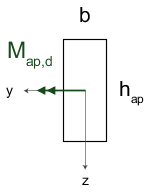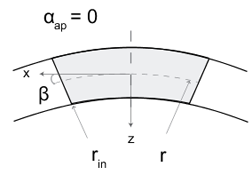Double tapered, curved, or pitched-cambered beams
Cross-sectional Inputs
All references to EN 1995-1-1:2004 unless otherwise stated.
This refers to glulam or LVL beams of a rectangular cross-section whose geometry changes symmetrically along its axis. These can be double tapered, curved, or pitched cambered beams.
The design is done for bending about the y-y axis, taking into account the effect of local bending, shear, and tensile (perpendicularly to the grain) stresses at the apex, according to Clause 6.4.3.

Timber Type
The Timber Type of the cross-section. Note that only glulam and LVL timber types are supported for this design.
Beam type
The user can selected between double tapered, curved, and pitched cambered beams.
Beam span l
The span of the beam, in mm.
Width bThe width of the cross-section, in mm. Depth hThe depth of the cross-section, in mm. Depth hapThe depth of the cross-section at the apex, in mm. |

|
Factor kvol
The volume factor kvol is required for Kerto-Q LVL where all veneers are not parallel to the beam axis.

Angle of the taper αap
The angle of the taper in the apex zone for a double tapered or pitched-cambered beam, in degrees.

Angle βThe angle of a curved beam in the middle of the apex zone, in degrees. Inner radius of curvature rinThis is the radius of curvature of the beam, measured to the centre of gravity of the beam, in mm. |

|
Lamination thickness t
The lamination thickness, in mm.

Area reduction
The area reduction ΔA refers to reductions in the nominal cross-section size that have to be taken into account in the calculation of the member strength (e.g. holes from fasteners) according to Subclause 5.2(2).
It should be given as a percentage of the total nominal area of the cross-section.
Section modulus reduction
The section modulus reduction ΔW refers to reductions in the nominal cross-sectional modulus that are to be taken into account in the calculation of the member strength (e.g. holes from fasteners) according to Subclause 5.2(2).
It should be given as a percentage of the total nominal section modulus of the cross-section.

Contribution of cross-section size on the determination of member strength properties
Includes factors kh for the calculation of the member strength in solid timber, glulam and LVL, according to Clauses 3.2, 3.3, and 3.4.
In the case of an LVL member under tension, the member length is also required.
Contribution of the load distribution system in the member strength properties
Includes factor ksys for the calculation of the member strength, according to Clause 6.6, for a member that functions as part of a continuous load distribution system.
Note that Subclause 6.6(3) states that the strength verification for a continuous load distribution system should be carried out assuming short-term load duration.
